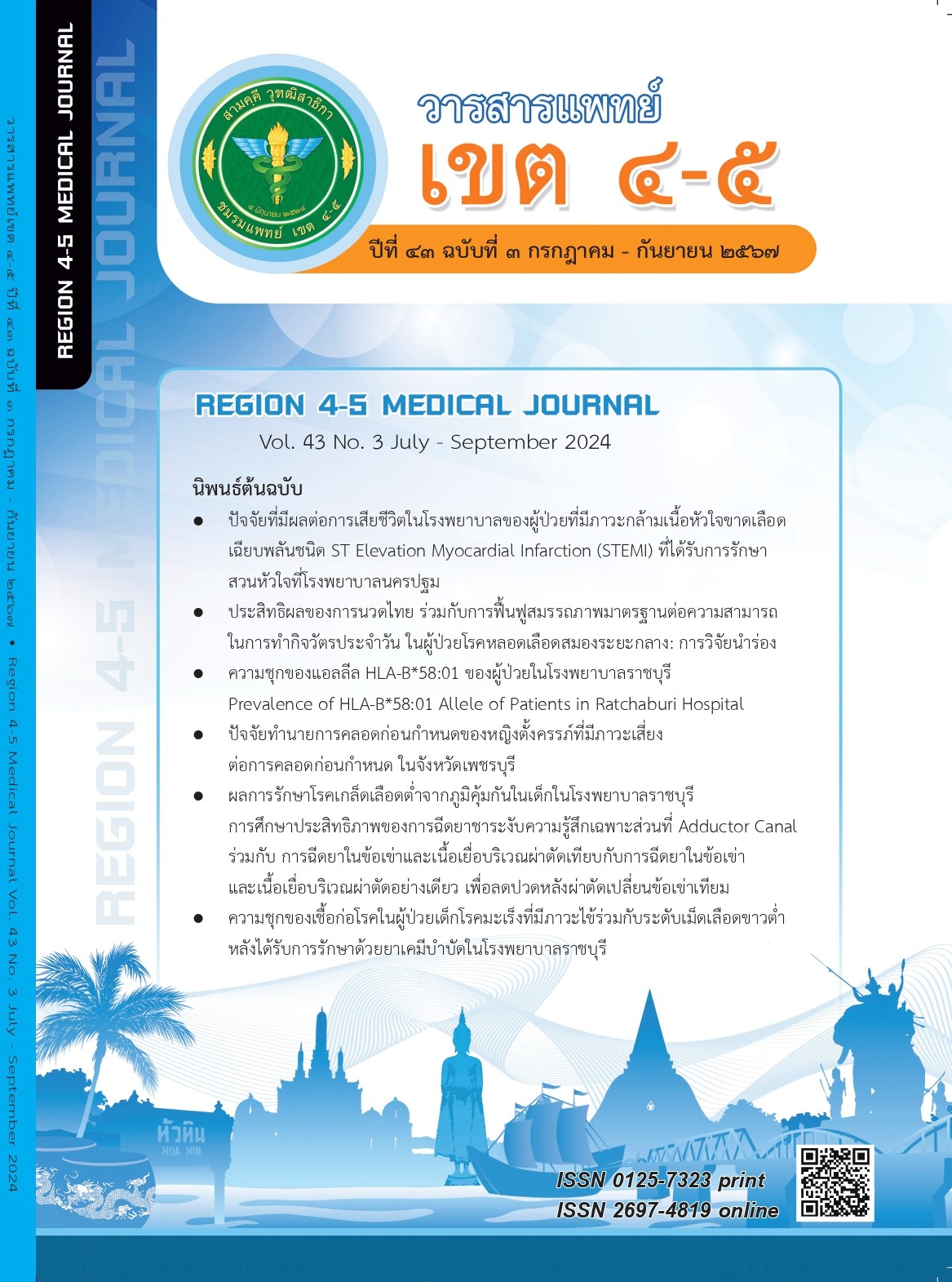Prevalence of HLA-B*58:01 Allele of Patients in Ratchaburi Hospital
Keywords:
HLA-B*58:01 allele, prevalence, allopurinolAbstract
Objective: The purpose was to study the prevalence of HLA-B*58:01 allele of patients in Ratchaburi Hospital and compare demographic data between HLA-B*58:01 positve patients and HLA-B*58:01 negative patients.
Methods: A retrospective study was carried out on all patients who visited Ratchaburi Hospital and had a blood test for the HLA-B*58:01 allele from January 1, 2017 to December 31, 2023, by collecting demographic data and relevant laboratory results. Statistical software was used to analyze the results, specifying numbers, percentages, means, and standard deviations. Compare the differences between groups was done using the chi-square test.
Results: A total of 144 patients were included in the study. The HLA-B*58:01 allele was detected in 25 cases, accounting for a prevalence of 17.4%. It was found that patients in the HLA-B*58:01 positive group were older, had lower BMI, and had asymptomatic hyperuricemia as an indication for using allopurinol significantly more often than patients in the HLA-B*58:01 negative group. In contrast, patients in the HLA-B*58:01 positive group had gout as a comorbidity and indication for using allopurinol significantly less than those in the HLA-B*58:01 negative group.
Conclusion: The prevalence of HLA-B*58:01 allele of patients in Ratchaburi Hospital was 17.4%.
References
สมาคมรูมาติสซั่มแห่งประเทศไทย. แนวทางเวชปฏิบัติการดูแลรักษาโรคเกาต์: Guideline for management of gout. กรุงเทพมหานคร: สมาคมรูมาติสซั่มแห่งประเทศไทย; 2555.
FitzGerald JD, Dalbeth N, Mikuls T, et al. 2020 American College of Rheumatology guideline for the management of gout. Arthritis Care Res (Hoboken) 2020;72(6):744–60.
doi: 10.1002/acr.24180.
ประกาศคณะกรรมการพัฒนาระบบยาแห่งชาติ. เรื่อง บัญชียาหลักแห่งชาติ พ.ศ. 2567. ราชกิจจานุเบกษา เล่ม 141, ตอนพิเศษ 53 ง. (วันที่ 4 มกราคม พ.ศ. 2567).
ศูนย์เฝ้าระวังความปลอดภัยด้านผลิตภัณฑ์สุขภาพ กระทรวงสาธารณสุข. สรุปรายงานอาการไม่พึงประสงค์จากการใช้ยา ประจำปี 2565 (Spontaneous report of adverse drug reaction 2022). กรุงเทพมหานคร: อักษรกราฟฟิคแอนด์ดีไซน์; 2566.
Limkobpaiboon S, Panomvana Na Ayudhya D, Dhana N, et al. Prevalence and mortality rate of severe cutaneous adverse reactions at Siriraj Hospital. Chula Med J 2010;54(5):467–77.
Saksit N, Tassaneeyakul W, Nakkam N, et al. Risk factors of allopurinol-induced severe cutaneous adverse reactions in a Thai population. Pharmacogenet Genomics 2017;27(7):255–63. doi: 10.1097/FPC.0000000000000285.
Do MD, Mai TP, Do AD, et al. Risk factors for cutaneous reactions to allopurinol in Kinh Vietnamese: results from a case-control study. Arthritis Res Ther 2020;22(1):182. doi: 10.1186/s13075-020-02273-1.
Fricke-Galindo I, LLerena A, López-López M. An update on HLA alleles associated with adverse drug reactions. Drug Metab Pers Ther 2017;32(2):73–87. doi: 10.1515/dmpt-2016-0025.
Sukasem C, Puangpetch A, Medhasi S, et al. Pharmacogenomics of drug-induced hypersensitivity reactions: challenges, opportunities and clinical implementation. Asian Pac J Allergy Immunol 2014;32(2):111–23.
Tassaneeyakul W, Jantararoungtong T, Chen P, et al. Strong association between HLA-B*5801 and allopurinol-induced Stevens-Johnson syndrome and toxic epidermal necrolysis in a Thai population. Pharmacogenet Genomics 2009;19(9):704–9. doi: 10.1097/FPC.0b013e328330a3b8.
Nguyen DV, Vida C, Chu HC, et al. Validation of a rapid, robust, inexpensive screening method for detecting the HLA-B*58:01 allele in the prevention of allopurinol-induced severe cutaneous adverse reactions. Allergy Asthma Immunol Res 2017;9(1):79–84. doi: 10.4168/aair.2017.9.1.79.
Ke CH, Chung WH, Wen YH, et al. Cost-effectiveness analysis for genotyping before allopurinol treatment to prevent severe cutaneous adverse drug reactions. J Rheumatol 2017;44(6):835–43. doi: 10.3899/jrheum.151476.
Nakkam N, Konyoung P, Kanjanawart S, et al. HLA pharmacogenetic markers of drug hypersensitivity in a Thai population. Front Genet 2018;9:277. doi: 10.3389/fgene.2018.00277.
Saokaew S, Tassaneeyakul W, Maenthaisong R, et al. Cost-effectiveness analysis of HLA-B*5801 testing in preventing allopurinol-induced SJS/TEN in Thai population. PLoS One 2014;
(4):e94294. doi: 10.1371/journal.pone.0094294.
Sukasem C, Jantararoungtong T, Kuntawong P, et al. HLA-B (*) 58:01 for allopurinol-induced cutaneous adverse drug reactions: implication for clinical interpretation in Thailand. Front Pharmacol 2016;7:186. doi: 10.3389/fphar.2016.00186.
Gonzalez-Galarza FF, McCabe A, Santos EJ, et al. Allele*Frequencies in Worldwide Populations. B*58:01 Thailand [Internet]. 2024 [cited 2024 April 11]; Available from: URL: https://www.allelefrequencies.net/hla6006a.asp?hla_locus_type=Classical&hla_locus=&hla_allele1=B*58%3A01&hla_allele2=B*58%3A01&hla_selection=&hla_pop_selection=&hla_population=&hla_country=Thailand&hla_dataset=&hla_region=&hla_ethnic=&hla_study=&hla_order=order_1&hla_sample_size_pattern=equal&hla_sample_size=&hla_sample_year_pattern=equal&hla_sample_year=&hla_level_pattern=equal&hla_level=&standard=a&hla_show=
Puangpetch A, Koomdee N, Chamnanphol M, et al. HLA-B allele and haplotype diversity among Thai patients identified by PCR-SSOP: evidence for high risk of drug-induced hypersensitivity. Front Genet 2015;5:478. doi: 10.3389/fgene.2014.00478.
Downloads
Published
How to Cite
Issue
Section
License

This work is licensed under a Creative Commons Attribution-NonCommercial-NoDerivatives 4.0 International License.
ลิขสิทธิ์บทความเป็นของผู้เขียนบทความ แต่หากผลงานของท่านได้รับการพิจารณาตีพิมพ์ลงวารสารแพทย์เขต 4-5 จะคงไว้ซึ่งสิทธิ์ในการตีพิมพ์ครั้งแรกด้วยเหตุที่บทความจะปรากฎในวารสารที่เข้าถึงได้ จึงอนุญาตให้นำบทความในวารสารไปใช้ประโยชน์ได้ในเชิงวิชาการโดยจำเป็นต้องมีการอ้างอิงถึงชื่อวารสารอย่างถูกต้อง แต่ไม่อนุญาตให้นำไปใช้ในเชิงพาณิชย์




